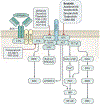Targeted Therapy in Chronic Lymphocytic Leukemia
- PMID: 31764118
- PMCID: PMC7039327
- DOI: 10.1097/PPO.0000000000000416
Targeted Therapy in Chronic Lymphocytic Leukemia
Abstract
Despite a prevailing view that advances in cancer therapy will come through selective targeting of enzymes encoded by mutated oncogenes responsible for the neoplastic phenotype, recent advances in the treatment of patients with chronic lymphocytic leukemia (CLL) have instead exploited knowledge of its biology. Indeed, CLL cells depend on interactions with cells and soluble factors present in the tumor microenvironment for proliferation and survival. B-cell receptor signaling and chemokine-receptor signaling play prominent roles. Elucidation of these signaling pathways has defined physiologic targets for drugs, such as ibrutinib, which inhibit Bruton tyrosine kinase and are therapeutically effective. The characteristic high-level expression of BCL2 in CLL that can enhance leukemia-cell survival has now become an Achilles heel targeted by clinically effective drugs such as venetoclax. Here we discuss advances in such targeted therapy and highlight other disease attributes, such as the distinctive expression of ROR1, which may be targeted for clinical benefit, alone or in combination with other targeted therapies.
Figures




References
-
- Robak T Therapy of chronic lymphocytic leukaemia with purine nucleoside analogues: facts and controversies. DrugsAging. 2005;22:983–1012. - PubMed
-
- Lukenbill J, Kalaycio M. Fludarabine: a review of the clear benefits and potential harms. LeukRes. 2013;37:986–994. - PubMed
-
- Hallek M, Fischer K, Fingerle-Rowson G, et al. Addition of rituximab to fludarabine and cyclophosphamide in patients with chronic lymphocytic leukaemia: a randomised, open-label, phase 3 trial. Lancet. 2010;376: 1164–1174. - PubMed
-
- Goede, Fischer K, Busch R, et al. Obinutuzumab plus chlorambucil in patients with CLL and coexisting conditions. N Engl J Med. 2014;370: 1101–1110. - PubMed

